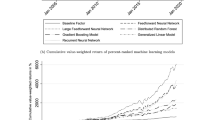Abstract
A vector autoregressive model is developed for predicting cash flow and returns in the private (unsecuritized) commercial property markets. The model predicts both of these variables quite well during the sample period. The forecasting model is then used to develop a simple “buy/sell” rule for identifying property market value peaks and troughs. An improved present value model, taking account of the predictability of property returns, is described and found to track historical market values much more closely than does either the appraisal-based index or the traditional present value model with constant expected returns. Analysis in this paper suggests that most of the change in commercial property market values has been due to changes in expected returns, rather than to changes in expected future operating cash flows.
Similar content being viewed by others
References
Barkham, R., and D. Geltner. (1995). “Price Discovery in American and British Property Markets,”Real Estate Economics (formerlyAREUEA Journal) 23, 21–44.
Campbell, J., and J. Ammer. (1993). “What Moves the Stock and Bond Markets? A Variance Decomposition for Long-Term Asset Returns,”Journal of Finance 48, 3–37.
Campbell, J., and J. Mei. (1993). “Where Do Betas Come From? — Asset Price Dynamics and the Sources of Systematic Risk,”Review of Financial Studies 6, 567–592.
Campbell, J., and R. Shiller. (1987). “Cointegration and Tests of the Present Value Models,”Journal of Political Economy 95, 1062–1088.
Campbell, J., and R. Shiller. (1988). “The Dividend-Price Ratio and Expectations of Future Dividends and Discount Factors,”Review of Financial Studies 1, 195–228.
Fama, E., and K. French. (1988). “Dividend Yields and Expected Stock Returns,”Journal of Financial Economics 22, 3–25.
Ferson, W., and C. Harvey. (1991). “The Variation of Economic Risk Premiums,”Journal of Political Economy 99, 385–415.
Geltner, D. (1993). “Estimating Market Values from Appraised Values Without Assuming an Efficient Market,”Journal of Real Estate Research 8(3), Summer, 325–346.
Giliberto, S.M. (1990). “Equity Real Estate Investment Trusts and Real Estate Returns,”Journal of Real Estate Research 5(2), 259–264.
Gyourko, J., and D. Keim. (1992). “What Does the Stock Market Tell Us About Real Estate Returns?”AREUEA Journal 20(3), 457–486.
Keim, D., and R. Stambaugh. (1986). “Predicting Returns in the Stock and Bond Markets,”Journal of Financial Economics 17, 357–390.
Liu, C., and J. Mei. (1992). “The Predictability of Returns on Equity REITs and Their Co-Movement with Other Assets,”Journal of Real Estate Finance and Economics 5, 401–418.
Liu, C., and J. Mei. (1994). “An Analysis of Real Estate Risk Using the Present Value Model,”Journal of Real Estate Finance and Economics 8, 5–20.
Mei, J., and A. Lee. (1994). “Is There a Real Estate Factor Premium?”Journal of Real Estate Finance and Economics 9, 113–126.
Mei, J., and C. Liu. (1994). “Predictability of Real Estate Returns and Market Timing,”Journal of Real Estate Finance and Economics 8, 115–135.
Shleifer, A., and L. Summers. (1990). “The Noise Trader Approach to Finance,”Journal of Economic Perspectives 4(2), Spring, 19–33.
Author information
Authors and Affiliations
Rights and permissions
About this article
Cite this article
Geltner, D., Mei, J. The present value model with time-varying discount rates: Implications for commercial property valuation and investment decisions. J Real Estate Finan Econ 11, 119–135 (1995). https://doi.org/10.1007/BF01098657
Issue Date:
DOI: https://doi.org/10.1007/BF01098657




